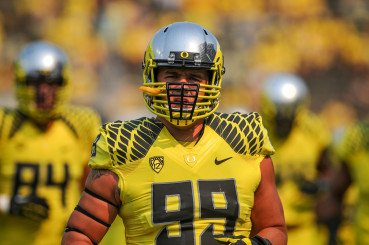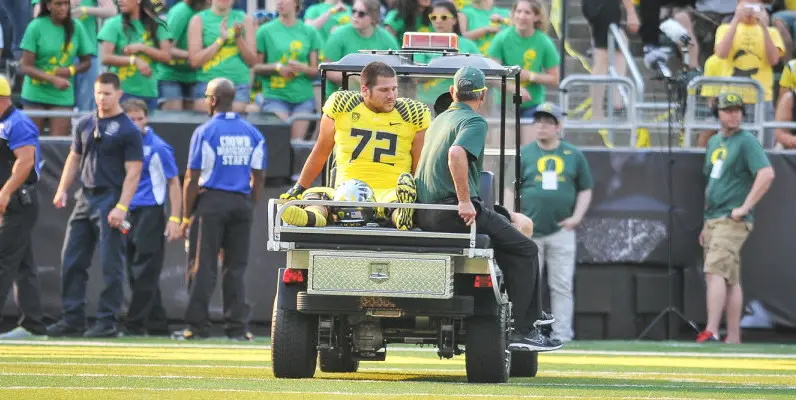As of last Thursday, two of Oregon’s big men, junior OL Andre Yruretagoyena and junior DL Sam Kamp, have officially retired from college football. Both Yruretagoyena and Kamp cited health concerns and will forgo their final seasons of playing eligibility, the latest in collegiate career casualties stemming from football’s new ”Super Size” era.
Oregon’s Andre Yruretagoyena won’t return for his senior season http://t.co/FPEJBB3aRH pic.twitter.com/MwykD2isyc
— Sports Illustrated (@SInow) February 27, 2015
Kamp, who added 30 pounds before the 2014 season, weighed in at nearly 300 pounds, a part of a team response to address increasing player size on both sides of the line. But just like so many college big men, the pain of carrying the extra weight became too much for Kamp to bear.
“My body was in pain a lot of times and I think, for a lot of guys, that weight works out well, but my body is just not meant to carry that much weight naturally, especially not playing at this high of a level,” Kamp told OregonLive.com.
In a recent study by AthleticScholarships.net, the average offensive lineman in NCAA Division I football weighs 294 pounds, and for defensive linemen, slightly less at 281 pounds. The biggest college offensive and defensive lines in the country, however, are well above those figures.

Sam Kamps recent retirement from college football raises issues over long term health concern for footballs big men.
According to Rene Nadeau of SportsNola.com, Ole Miss boasts the largest line in the nation, with the average starting lineman tipping the scales at a whopping 6’4.4″ tall and 334.2 lbs.
In the same poll, Nadeau has Oregon’s average lineman size at 6’4.4 and 292 lbs. The largest individual from Nadeau’s unofficial report is Tulane‘s offensive guard Jason Stewart, whose 6’4″ frame carries 395 lbs.
The pressure is increasing for high school linemen to start putting on weight as well, dismissing the longtime high school football coaching adage of waiting until college to “make your body a business.”
In a New York Times article, Robert M. Malina, professor emeritus of kinesiology at Texas, said the recent weight increase trend in young football players is staggering. “Youngsters are already being rewarded for being big and overweight before playing big-time football,” Malina said.
Malina added that the heavyweight era in football “puts a premium on big boys the way gymnastics puts a premium on small, underweight girls.”
Read This: “College Football’s Obesity Playbook | Planned weight gains persist into unhealthy adult obesity. Changes? http://t.co/4yq869Vity
— Edmund Sullivan (@ManWithaHat) October 5, 2014
Many linemen at the collegiate and professional levels are considered by doctors as technically obese, leading to an increased risk of heart disease, high blood pressure, diabetes and vulnerability to long-term muscle and joint pain later in life.
While the Oregon football program will surely miss the talents and size of Kamp and Yruretagoyena, a lifetime of good health trumps that of an unhealthy champion.
Top Photo by Kevin Cline
Related Articles:
Chip Kelly Update: Everything's Good Again ...
Chip Kelly Update: Wailing and Gnashing of Teeth
Shock and Awe -- The Oregon Ducks' Football Hangover Effect
Despite Lopsided Score, Georgia State "Never Stopped Believing"
Hope Springs Eternal for Ducks
Incompetent Pac-12 Officials: How Do You Miss ALL of THIS?

Jordan is a lifelong Duck fan currently living in San Diego. Jordan graduated from The Evergreen State College in Olympia, Washington, after serving a prestigious fellowship with the Washington State House of Representatives. Upon graduation, he worked as an English language teaching assistant for the Spanish Ministry of Education’s Ambassadorial Program in Monforte de Lemos, Spain. Jordan has worked as a journalist, writer, and editor in Oregon, Washington, Montana, and California, covering a wide range of topics, including sports, local politics, and crime. He is VERY excited to be writing about his beloved Oregon Ducks.

